Travel
The Tweed Valley Canoe Trail: A three-day canoe trip into Scotland’s sublime borderlands
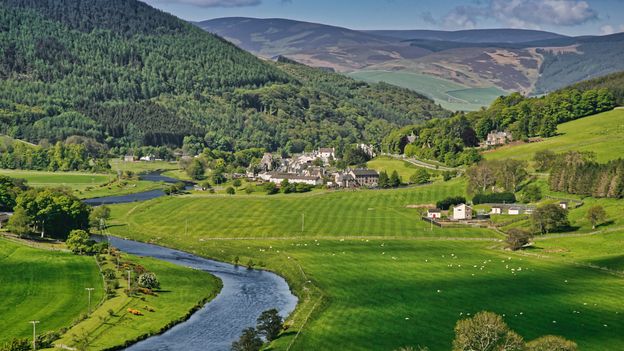
By Stuart Kenny,Features correspondent
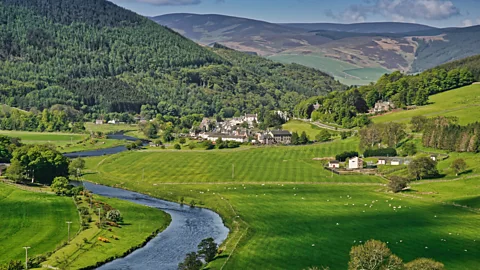 Ian Linton Photography
Ian Linton PhotographyThe first official canoe trail in the south of Scotland just launched, covering a 30-mile stretch of the majestic River Tweed.
The River Tweed doesn’t just run through the Scottish Borders region. In its lower reaches, the river itself forms the border – the Anglo-Scottish divide tracing the twists and turns of the Tweed for 17 miles. This has loosely been the case since the Battle of Carham in 1018, where Malcolm II of Scotland defeated Uhtred, the English ruler of Bamburgh. It has legally been the case since the 1237 Treaty of York, agreed between Henry III of England and Alexander II of Scotland.
Battles have been won and lost in that time, but the border hasn’t budged much since.
“Neidpath is just around this bend,” said Craig Kerr, my river guide, as our canoe sailed through the skewed stone arch of a sandstone viaduct. Either side of the water, a patchwork forest of Scots pine, larch and beech layered steeply up the riverbanks. As the blue blur of a kingfisher led our boat around a river switchback, the ancient, imposing fortification of Neidpath Castle was unveiled high above.
I was an hour into the new Tweed Valley Canoe Trail, which officially opens on 1 May and covers a 30-mile stretch of the river from the hamlet of Stobo to Abbotsford, the stately home of the writer Sir Walter Scott. This route runs purely through Scottish waters, roughly 60 miles west of where the river becomes a shared waterway. It’s the first official canoe route to open in the south of Scotland, waymarked and mapped, and it travels through a landscape shaped by – and which has shaped – Scottish history.
A castle was first built on the site of Neidpath around 1190. One early owner, Sir Simon Fraser, fought alongside William Wallace and later met the same grizzly fate – his head ending up on a spike on London Bridge. The current sublime, rubble-built tower of Neidpath dates to the late 14th Century. It’s perhaps most notable for the “crumbly corner”; the upper storeys of one wing having collapsed after an attack from Oliver Cromwell in 1650 and subsequent neglect.
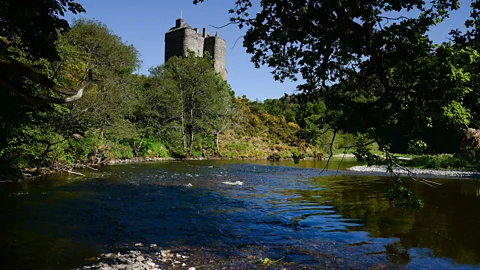 Tweed Forum
Tweed ForumA lot is written about the unpredictable Scottish climate, but on dreich (overcast) days like today, the romance of the history seems to seep out of the stonework like a diffuser scenting the air.
When and how to go:
The journey is best enjoyed between April and September, avoiding the peak salmon fishing season in October and November. There are wooden way markers, anchor points and informative signage dotted along the route at each suggested stop. Plan your trip here.
Neidpath is one of more than 100 fortified “peel towers” built in the Borders during this period to serve as watchtowers. If one tower lit a signal fire – like the beacons of Gondor in The Lord of the Rings – others followed suit.
The water levels of the Tweed can move up and down like a fiddler’s elbow, and on that day as Kerr and I paddled down the river, the water levels were high and the current ran like a motorway. “You can usually duck under these branches,” said Kerr, as we dodged a submerged tree.
The trail is designed to be paddled over two long or three shorter days – either self-guided or led by a guide like Kerr. I’d opted for the latter on both counts. Kerr runs Biggar Adventures and has been guiding tours on the Tweed for more than a decade. “Canoeing gives you a new perspective on a familiar landscape,” he said. “It’s always different.”
Our first docking point was at the bucolic town of Peebles, where we tied up our boat and strolled to lunch, passing a sculpture of leaping salmon. The town motto of Contra Nando Incrementum (Against the Stream We Multiply) hung outside the old County Inn. Peebles is also home to a museum dedicated to famed local John Buchan, author of The 39 Stepsand an ex-Governor General of Canada. “He was a great fisherman,” said museum volunteer David Brackenridge. “He had a strong connection with the river.”
 Ian Linton Photography
Ian Linton PhotographyThe whole of the River Tweed now doubles as a wildlife corridor, and not just for salmon. We passed parcels of squeaking oystercatchers as we paddled downstream, and herons and cormorants were regular sightings. “I once watched an osprey dive down to catch a fish,” said Kerr.
Our first stage ended in Innerleithen, an ex-textile town where mountain bike trails share signposts with listed historical sights. I ate and slept at the family-run Traquair Arms hotel, nipping next door to sample the products at Durty Brewing, where each beer is named after a local biking route. The next morning, with a shorter second day in the canoe ahead, I set out to climb Pirn Hill on the outskirts of town. At the summit of the hill sits a 2,000-year-old fort complex. In its centre is a ring of carved stone panels depicting the history of the area, from Romans and Celtic monks to mighty Tweed salmon and the mills once so prevalent here.
Across the water is Traquair, Scotland’s oldest inhabited house. I crossed the Tweed Bridge to visit and was greeted by Catherine Maxwell Stuart, 21st Lady of Traquair, and her two sprightly King Charles spaniels. Traquair House dates to 1107 and it’s been visited by 27 Scottish kings and queens in that time.
The Stuarts of Traquair were fervent Jacobites, even hosting Bonnie Prince Charlie during the Jacobite uprising of 1745. When the prince left Traquair, he did so via the Bear Gates – a set of metal gates guarded by stone bears at the front of the house. “The story goes that the Earl of Traquair promised they wouldn’t be opened again until a Stuart king returned to the throne,” said Lady Maxwell Stuart. They’ve remained closed ever since and the current entrance is still referred to as “the temporary drive”.
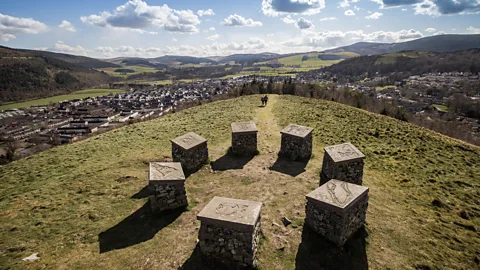 Ian Linton Photography
Ian Linton PhotographyInside, Traquair is a maze of wood carvings, tapestries and eye-catching artefacts such as rare Jacobite glasses and wooden stilts that were used to cross the river back when local bridges were less numerous.
Traquair estate actually altered the course of the Tweed by a few hundred metres in the late 1600s, when it was believed the river was damaging the foundations of the house. In one of Traquair’s chapels, you can still find a trapdoor (in a cupboard, behind a bookshelf) that would have led out to the waterway. The idea was that, should a Protestant mob arrive in an angry furore – which did happen over the centuries – any resident priest would’ve been able to escape out to the river and sail away.
I strolled (rather than fled) back to the river to meet Kerr, and we headed off on stage two of the trail, paddling past Plora Wood‘s native oak woodland – today a rarity in the Borders. With the current on our side, the paddling became meditative and methodical, with forestry, farmlands and the ruins of old peel towers coming and going with the river bends.
Day two ended among wild garlic and daffodils near Peel, a tiny hamlet on the edge of Yair Forest, where the 500-year-old Glenkinnon Oak stands strong. There are fine wild camping spots here, but instead I sought solace in the nearby Clovenfords Hotel, guarded by a statue of Sir Walter Scott.
Our final day of paddling took us seven miles to Scott’s legendary country house. It was a day of rapids, the most notable of which came beneath the scenic stone Fairnilee Bridge, built back in 1764. “It’s unlikely we’ll tip over,” Kerr said reassuringly, “but we’re definitely going to get wet.” I didn’t have too much time to appreciate the local architecture before the white water hit.
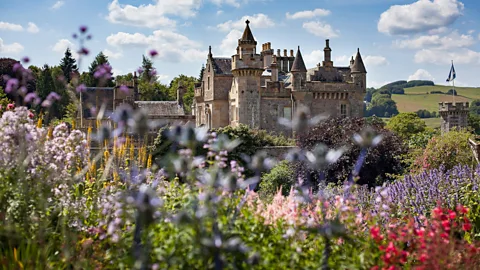 The Abbotsford Trust
The Abbotsford Trust“The best thing to do is relax,” Kerr shouted, as half the Tweed landed on my lap. We were bounced around, but true to his word, our canoe stayed upright. Giggling away, we pulled over to empty our boat, which at this point was more of a bathtub. Our reward was a quiet final four miles, lilac silver birch blending with orange larch and lichen-heavy oaks to paint a quietly beautiful finale to the trail.
The Scots baronial architecture of Abbotsford soon came into sight, as much miniature castle as stately home, sprawling along the banks of the Tweed with fairy-tale turrets pointed to the sky. This sight meant the trail was at an end. Climbing out of the canoe, I crossed Galafoot Bridge to explore the famous home.
Sir Walter Scott’s The Waverley Novels transformed the world’s view of Scotland, romanticising Highland landscapes and clan causes. “Scott broke pretty much every publishing record there was to break,” said Kirsty Archer-Thompson, collections and interpretation manager at Abbotsford.
It’s hard to overstate the impact the writer had on Scotland, and indeed, the impact the Tweed had on Scott. “It was a love affair he had with this river, and with this idea that it encapsulated the Borders,” said Archer-Thompson, noting that Scott helped set up the River Tweed Commission, the body still responsible for the health of the river. “It’s part of his legacy that we can enjoy it today.”
From here, I headed to Galashiels, one of the biggest towns in the Borders, and caught the train to Edinburgh Waverley – the capital’s principal station, which is named for Scott’s books. The Tweed continues east from Abbotsford. Before it flows into the North Sea, its cultural tributaries stretch far and wide through Scotland. This is a river that set the borders of this historic nation, and inspired those who built its modern image.
Slowcomotion is a BBC Travel series that celebrates slow, self-propelled travel and invites readers to get outside and reconnect with the world in a safe and sustainable way.






